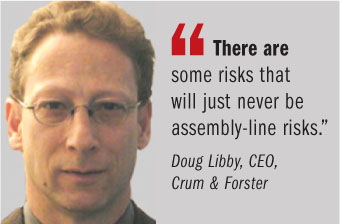For the CEO of Crum & Forster, Doug Libby, who voluntarily describes himself as “a contrarian,” there is little not to like about the $294 million deal, closed in February, that adds First Mercury Financial Corp. to his group's specialty-insurance operations.
Libby believes First Mercury's excess-and-surplus lines businesses gel perfectly with the “out-of-the-box” thinking and underwriting culture that he has ingrained in C&F's admitted-specialty operations for over a decade.
 The former lawyer, who once worked as general counsel for an investment-banking firm, draws a parallel to the arbitrage departments of Wall Street firms as he describes his approach to the insurance business—a strategy he has followed since becoming CEO of Seneca Insurance (now a subsidiary of C&F) in 1989.
The former lawyer, who once worked as general counsel for an investment-banking firm, draws a parallel to the arbitrage departments of Wall Street firms as he describes his approach to the insurance business—a strategy he has followed since becoming CEO of Seneca Insurance (now a subsidiary of C&F) in 1989.
Recommended For You
Want to continue reading?
Become a Free PropertyCasualty360 Digital Reader
Your access to unlimited PropertyCasualty360 content isn’t changing.
Once you are an ALM digital member, you’ll receive:
- Breaking insurance news and analysis, on-site and via our newsletters and custom alerts
- Weekly Insurance Speak podcast featuring exclusive interviews with industry leaders
- Educational webcasts, white papers, and ebooks from industry thought leaders
- Critical converage of the employee benefits and financial advisory markets on our other ALM sites, BenefitsPRO and ThinkAdvisor
Already have an account? Sign In Now
© 2025 ALM Global, LLC, All Rights Reserved. Request academic re-use from www.copyright.com. All other uses, submit a request to [email protected]. For more information visit Asset & Logo Licensing.








